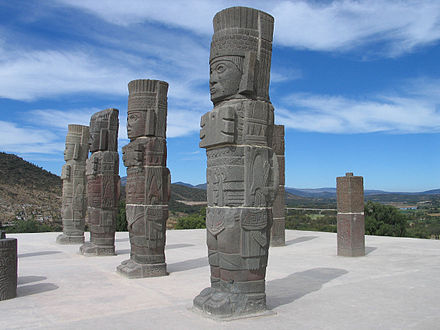Tula de Allende - municipality of Mexico
Tula de Allende is in the Hidalgo region of Mexico. It is an archeological site of a city destroyed in the 12th century at some time between 1168 and 1179. Tula became the capital city following Teotihuacan.
It is now a major tourist attraction in the state of Hidalgo.
The famous columns resembling Aztec warriors and the pyramid ruins are the most visited part of the ruins.
Understand
 The city of Tollan-Xicocotitlan emerged during the decline of the Teotihuacan culture and was established as a powerful center of influence in Mesoamerica until the 12th century. After its flowering stage, the city was partially abandoned and the region was occupied by the Mexica culture until the conquest of Mexico.
The city of Tollan-Xicocotitlan emerged during the decline of the Teotihuacan culture and was established as a powerful center of influence in Mesoamerica until the 12th century. After its flowering stage, the city was partially abandoned and the region was occupied by the Mexica culture until the conquest of Mexico.
The ruins of the ancient Toltec capital lie north of modern Tula de Allende, which was a small town dedicated to the countryside until the mid-20th century, when the region experienced a significant investment in the development of the cement industry, oil refining and energy production. While the south and east of the city showed a profound change, the west of the municipality remained a predominantly rural area with a more subdued pace of life.
Get in
There are at least 1-2 buses every hour from Mexico City's Northern Bus Terminal (Autobuses del Norte) to Tula's bus station, which is located in Xicoténcatl Street:
Tula Bus Station (Central de Autobuses de Tula), Xicoténcatl Street, 20.052958°, -99.339787°.
Fees and permits
Get around
From the bus station, you can easily walk to the city center (Cinco de Mayo St, Zaragoza St, Quetzalcoatl St). From there, you can walk north on the pleasant pedestrian Quetzalcoatl St until the little pedestrian bridge over the Tula River. From the bridge, it is only a short walk, with good views, to the southern, pedestrian gate of the Tula Archaeological Area. As of the late 2013, that southern gate is usually closed; the main (northeastern) gate is about a mile away, and while you can walk there (along Avenida del Tesoro and Boulevard Tula), the walk is not pleasant.
There are some city buses, including a route that passes near the bus terminal (the bus stop is called "Elektra") and near the archaeological zone's main entrance (the stop is in Boulevard Tula, near the turn off to the archaeological zone).
See
- Zona Arqueológica y Museo de sitio de Tula (Tula Archeologic Area and Museum), 20.06395°, -99.34078°. 09:00-17:00 daily. These are the ruins of Tollan-Xicocotitlan, the ancient capital of the Toltecs. The centerpiece of the site is Pyramid B with giant stone statues on top. There is also a small museum with archaeological artefacts.
- St Joseph Cathedral (Catedral de San José de Tula), Cinco de Mayo and Zaragoza St, 20.05515°, -99.34321°.
Do
Buy
Eat
There are plenty of inexpensive eateries in Xicoténcatl St, near the bus station. More restaurants can be found in the city center (specifically, Quetzalcoatl St between Zaragoza St and Moctezuma St).
Drink
Sleep
Lodging
- Hotel Casablanca, Pasaje Hidalgo No. 11 Col. Centro (From the Pl.Constitucion, walk south on Atanacio Bernal. Pasaje Hidalgo (not to be confused with Calle Hidalgo) is a small alleyway on your left.), 20.05458°, -99.34198°, +52 773 7321186. Straightforward business hotel. Breakfast not included, good wifi. M$400 2015-07-24
Camping
Backcountry
Stay safe
Go next
Tula de Allende
tula.gob.mxHidalgo
Primary administrative division